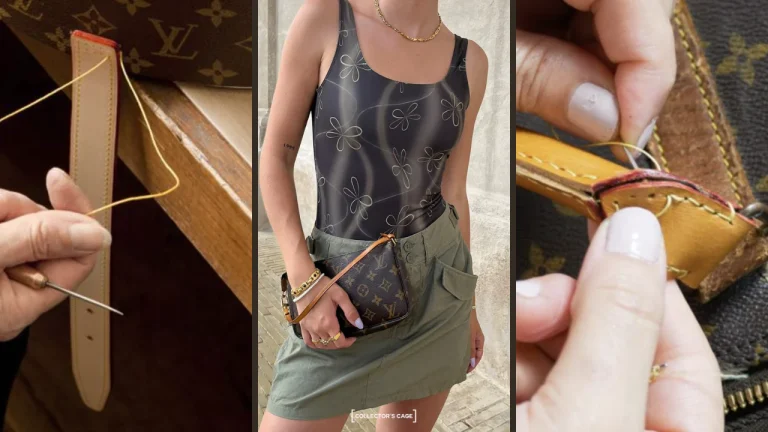Louis Vuitton, the epitome of luxury fashion, has crafted a name synonymous with timeless style and elegance. One of the defining aspects of its legacy is its pioneering collaborations with artists, which have consistently brought fresh, avant-garde elements to its collections.
These partnerships have redefined the brand’s narrative and introduced innovative interpretations of its classic designs, giving rise to iconic vintage Louis Vuitton pieces that collectors and fashion enthusiasts continue to revere. This article will explore the top five artist collaborations that have cemented Louis Vuitton’s place as a bridge between fashion and art.
Table of Contents
The Stephen Sprouse Revolution: Graffiti Meets Elegance
In 2001, under Marc Jacobs’ direction, Louis Vuitton partnered with American artist Stephen Sprouse, who was renowned for his graffiti-inspired artwork. This collaboration was groundbreaking as it blended the rebellious, streetwise aesthetic of graffiti with the luxury and sophistication of Louis Vuitton’s monogram canvas. The result was a collection that juxtaposed bold neon lettering with classic high-fashion materials, redefining the boundaries of luxury fashion.
Sprouse’s touch on the iconic monogram breathed new life into it, creating a collection that has become highly sought-after among collectors of vintage Louis Vuitton. This line was pivotal in positioning the brand as an innovator willing to break traditional molds, inspiring future collaborations and cultivating a reputation for daring creativity.
Takashi Murakami’s Playful Pop Art Influence
The 2003 partnership between Louis Vuitton and Japanese contemporary artist Takashi Murakami was a defining moment for the brand. Murakami, known for his “superflat” art style that blends traditional Japanese art with contemporary pop culture, infused the classic monogram with vibrant colors and playful motifs. The result was the Multicolore Monogram collection, which was an instant success.
This collection brought a new demographic to Louis Vuitton, appealing to younger, fashion-forward audiences who admired its whimsical yet sophisticated charm. Murakami’s collaboration not only introduced fresh aesthetics but also solidified the brand’s willingness to explore unconventional themes. Today, pieces from the Murakami collection are coveted items in the world of vintage Louis Vuitton, underscoring their lasting impact on the fashion industry.
Richard Prince’s Painterly Touch: The Aquarelle Monogram
Louis Vuitton’s 2008 collaboration with American artist Richard Prince took a different artistic direction. Prince, known for his use of rephotography and layered imagery, brought a sense of whimsy to the monogram with his watercolor-inspired designs. The Aquarelle Monogram collection, sometimes referred to as the “Watercolor Monogram,” featured a light and airy reinterpretation of the traditional LV pattern.
Prince’s input on the collection highlighted Louis Vuitton’s ability to fuse fine art with functional design seamlessly. The delicate use of colors added a new dimension to the monogram canvas, making the collection a unique and cherished addition to vintage Louis Vuitton archives. This partnership not only exemplified the brand’s ongoing artistic evolution but also bolstered its reputation for incorporating artistic narratives that resonate across generations.
Yayoi Kusama’s Polka Dot Obsession
The 2012 collaboration with Yayoi Kusama, an artist celebrated for her signature polka dots, marked another creative milestone for Louis Vuitton. Kusama’s motifs are both playful and profound, symbolizing infinity and her lifelong fascination with repetitive patterns. This partnership saw polka dots covering everything from bags and shoes to dresses and accessories, creating a visually striking collection that resonated with art and fashion lovers alike.
Kusama’s distinctive approach allowed Louis Vuitton to further cement its status as a brand unafraid of bold artistic statements. The collection’s emphasis on repetitive, eye-catching patterns not only reimagined the traditional aesthetic but also contributed to the collectability of items from this line as modern classics within the vintage Louis Vuitton market. This partnership celebrated the fusion of contemporary art with high fashion, leaving an indelible mark on the brand’s legacy.
The Foundation of Art: Louis Vuitton’s Contemporary Art Museum
Perhaps the most substantial testament to the brand’s dedication to the arts is the establishment of the Louis Vuitton Foundation for Contemporary Art in 2014. This philanthropic endeavor, spearheaded by Bernard Arnault, showcases the brand’s deep-rooted commitment to art and culture. The foundation hosts exhibitions, performances, and collections from artists around the globe, further bridging the gap between fashion and art.
The creation of this foundation elevated Louis Vuitton from being merely a luxury fashion house to becoming a key patron in the global art community. The foundation’s innovative approach has inspired both artists and fashion enthusiasts, reinforcing the brand’s legacy as a visionary leader in merging art with fashion. The influence of these artistic pursuits continues to ripple through new collections and keeps vintage Louis Vuitton pieces connected to an ongoing cultural dialogue.
Keeping the Legacy Alive: Why Art and Fashion Matter
Louis Vuitton’s partnerships with groundbreaking artists have continually pushed the envelope of what luxury fashion represents. Each collaboration brings a fresh perspective, adding unique value and ensuring the brand’s collections remain highly sought after even decades later. These collaborations not only give rise to coveted vintage Louis Vuitton pieces but also highlight the brand’s role in pioneering fashion as a form of cultural and artistic expression.
From the graffiti-splattered monograms of Stephen Sprouse to the whimsical worlds of Murakami and Kusama, Louis Vuitton’s artist partnerships have set a benchmark in the fashion industry. They show that luxury is not only about maintaining traditional elegance but also about daring innovation and artistic engagement. For enthusiasts and collectors alike, these pieces are more than just fashion statements—they are testaments to Louis Vuitton’s legacy of creativity and visionary collaboration.
